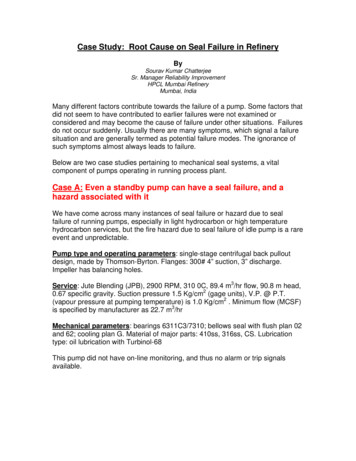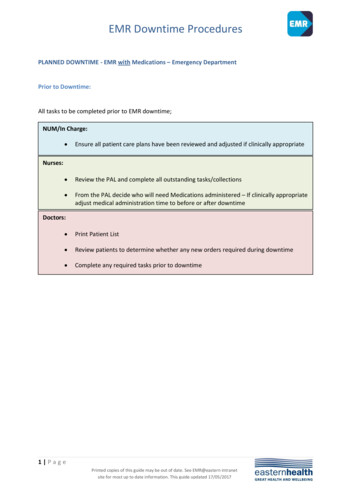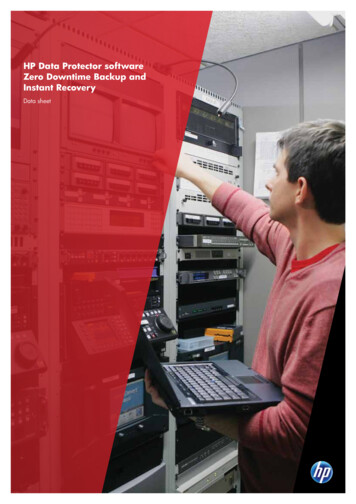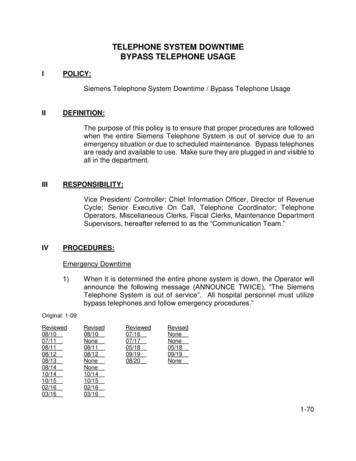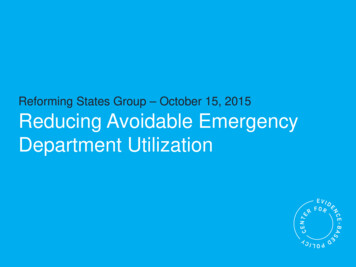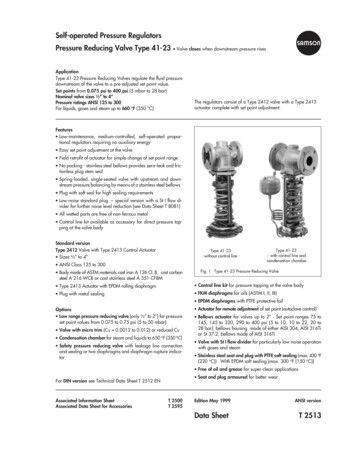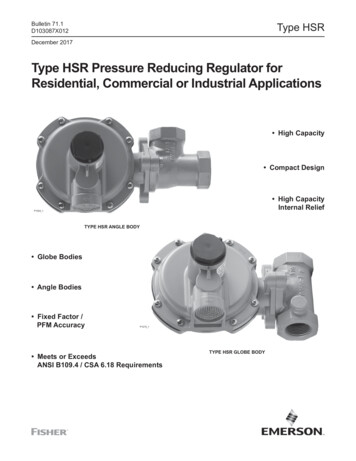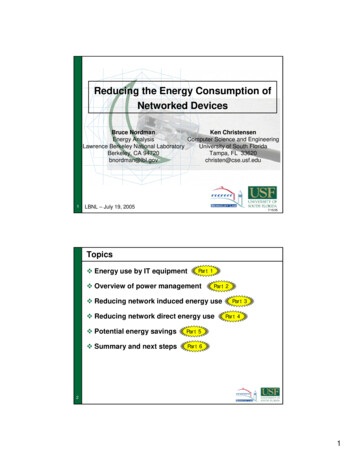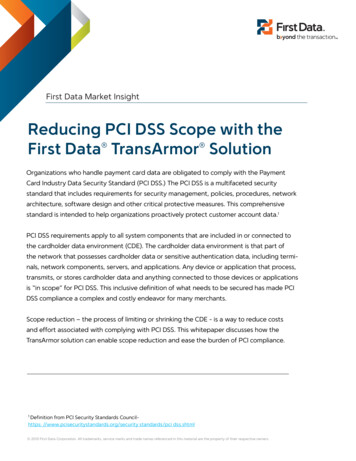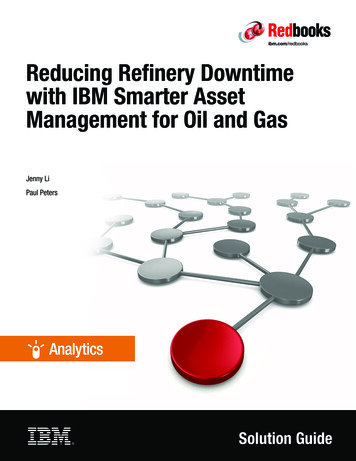
Transcription
Front coverReducing Refinery Downtimewith IBM Smarter AssetManagement for Oil and GasJenny LiPaul PetersSolution Guide
Reducing Refinery Downtime with IBM Smarter AssetManagement for Oil and GasIBM Smarter Asset Management for Oil and Gas gives oil and gas companies directvisibility into asset usage and operational health. It helps executives and managers makedecisions that are based on accurate, up-to-date reports of the running conditions andperformance of their most critical assets. It also includes predictive analytics features that canhelp companies get ahead of the curve in terms of plant maintenance and turnarounds.By combining sensor-based condition monitoring with advanced analytics, Smarter AssetManagement for Oil and Gas delivers data-driven insights to aid in daily operations, shutdownand turnaround management, and regulatory compliance. It helps reduce asset downtime byensuring maintenance is performed exactly (and only) when needed, and increases overallproductivity, which increases operational equipment efficiency (OEE).The solution (see Figure 1) delivers the following vital functions: Traditional asset management: Extends the lifecycles of vital machinery; optimizesmaintenance and repair cycles (including work order management), and integrates withenterprise systems for procurement, enterprise resource planning (ERP), and more. Predictive maintenance and quality (PMQ) control: Monitors equipment health to predictfailures and other actionable events; identifies the root causes of downstreamperformance bottlenecks, and reduces health, safety, and environment (HSE) risks. Turnaround management: Identifies the best times for plant shutdowns; proactivelymanages complex turnaround issues, and collaborates with key Business Partners toestablish asset-management related triggers and business flows.Figure 1 Primary use cases of IBM Smarter Asset Management for Oil and Gas Copyright IBM Corp. 2016. All rights reserved.ibm.com/redbooks1
Did you know?IBM can help you implement Smarter Asset Management for Oil and Gas in your enterprise.Our consultants can assess your current asset data integration issues and identify specificproducts and configurations that can help.Smarter Asset Management for Oil and Gas combines the IBM Internet of Things (IoT)Foundation to connect real-time data from field-based sensors to the enterprise systems, IBMMaximo Oil and Gas for asset management, and IBM Maximo Scheduler for turnaroundmanagement. Typical configurations also include IBM PMQ for predicting asset failures andproviding maintenance recommendations, and Maximo Anywhere (or IBM MobileFirst onIBM Bluemix ) to enable mobile access to many features.Business valueIn addition to keeping production costs low, the biggest priority for oil and gas companies is tokeep the plant safely up and running so that production is uninterrupted. If an asset is notperforming to specifications, it can become a liability to the company and negatively affectproduction.Benefits of Smarter Asset Management for Oil and Gas fall into the following broadcategories: Reduce operational costSeveral cost categories can be mitigated by implementing a comprehensive assetmanagement solution with advanced analytics:– Maintenance: An asset management solution can identify the best time to performmaintenance rather than doing it based on a specific schedule or recommendation.You can also optimize your spare parts inventory to trim costs because of overstocking.– Turnarounds: An asset management solution that uses predictive and optimizedmaintenance techniques can help you better plan for plant turnarounds and reduceassociated costs. Because turnarounds typically involve shutting down all or part of theplant, optimizing any part of the process almost always saves money.– Field operations: When failures can be predicted in advance, equipment can berepaired or replaced before it fails. This predictive feature leads to fewer interruptions infield operations and reduces wasteful non-production time. Increase production and efficiencyIf an asset management solution can reduce maintenance durations, the natural benefit isincreased production. Less time is needed for maintenance and turnaround efforts;therefore, the refinery can keep producing with far less interruption. Improve facilities maintenanceCommon goals that are related to facilities maintenance include optimizing logistics andequipment scheduling and improving equipment capacity, availability, and utilization. Acomprehensive asset management solution helps to achieve these goals, which, in turn,promotes the reliability of the equipment (including rotating equipment) and other assets.2Reducing Refinery Downtime with IBM Smarter Asset Management for Oil and Gas
Forecasting and allocationsBecause the solution allows for greater visualization and analysis of operations data(current and projected), it can help oil and gas companies better understand and forecastfuture production output. In addition to better forecasting, insight into the reliability of theavailable equipment allows companies to better allocate assets to reach production goals.Solution overviewSensors are used to monitor equipment throughout a refinery, including crude oil distillationunits, vacuum distillation units, catalytic reformer units, distillate hydrotreater units, fluidcatalytic crackers, and more. Smarter Asset Management for Oil and Gas uses this sensordata (flow rate, temperature, pressure, air-fuel ratio, oxygen content, vibration, corrosion, andother readings) with other information, such as recommended and actual maintenanceschedules, to create analytical models that can predict everything from fractional distillationperformance to expected equipment failures.The solution is designed to collect the sensor data in time series format and store it in adatabase (for example, OSIsoft’s PI System) or stream it directly to the involved solutioncomponents by using a publish/subscribe model. The sensor readings can be augmentedwith process data, such as maintenance logs, production reports, geospatial coordinates, andvideo and still images. Together, this data fuels the creation of predictive analytic andoptimization models that are designed to support better decision making.Smarter Asset Management for Oil and Gas includes the following main logical componentsor layers: Data AcquisitionThis layer uses adapters to connect to the sensors, databases, and other data sources tobe analyzed. It is responsible for integrating or referencing pertinent data into the solution,where the Data Services component facilitated its use by the remaining components. Data ServicesThis layer stores the data for access by advanced analytical processes. It provides asemantic understanding of the data for the involved applications (analytics, visualization,enterprise asset management, and so on), and ensures that it is consistent with themaster data from any enterprise systems of record that are in place. Advanced AnalyticsThis layer uses predictive models to identify potential asset failures, which allowsmaintenance work orders to be issued. In this way, maintenance is performed only whenneeded. This layer can also be used to optimize work schedules for turnaroundmanagement. Role-based VisualizationThis layer provides users with the relevant visualizations they need to perform their roles(such as Plant Supervisor, Plant Operator, and Maintenance Specialist). Solution ManagementThis layer manages the overall solution. Among other things, it provides services for theinstallation and configuration of the solution’s software components, services for themonitoring, logging, and auditing the solution, and various administrative tools.3
Solution architectureSome of the most advanced products and software from IBM enable Smarter AssetManagement for Oil and Gas to maximize its performance. This section describes the solutionarchitecture (see Figure 2).Figure 2 Suggested architectural configuration of IBM Smarter Asset Management for Oil and GasThe IBM IoT Foundation makes it easy to collect and transmit data from sensors and devicesthanks to its use of the IBM Bluemix cloud development platform. Device events, such asthose from refinery equipment or other assets, are collected and stored in time-series formatin a database.IBM InfoSphere StreamsIBM InfoSphere Streams enables real-time basic analytic processing of data streams, suchas those from production fields. These fields generate massive volumes of moving data (suchas flow rates, temperatures, and tank levels) that must be continuously analyzed to improvebusiness insight and decision making.IBM Maximo Oil and GasIBM Maximo Oil and Gas is a product bundle that includes all of the core asset managementfunctions of IBM Maximo Asset Management along with incident management and othercapabilities from IBM Maximo Health Safety and Environment Manager. The data that it usescan come from various sources, including monitored devices, databases, or files.Maximo Oil and Gas integrates data from external systems (such as enterprise assetmanagement systems and ERP systems) in batch mode and supports HTTP, JMS, and webservices protocols. After the external systems are configured, automated tasks andschedules can be set to collect the wanted sensor or device data.4Reducing Refinery Downtime with IBM Smarter Asset Management for Oil and Gas
Maximo Oil and Gas provides an asset information model that can link related information. Italso features reporting and dashboard capabilities that are provided through the integration ofIBM Cognos Business Intelligence. Third-party visualization data, such as maps orgeospatial data, can be integrated into the dashboards. If remote access is wanted, MaximoOil and Gas includes Maximo Anywhere to enable connecting to the system from mobiledevices.IBM Enterprise Asset Management - Inventory Analytics on CloudIBM Enterprise Asset Management - Inventory Analytics on Cloud adds predictive analytics toMaximo’s inventory module. It uses IBM SPSS , which is running in the cloud, to link to theinventory database of an on-premises Maximo system and enables users to profile inventory(including tracking and reporting movements of inventory items and the amount of each itemon hand), predict out-of-stock conditions, and reduce overstocking.IBM Maximo SchedulerIBM Maximo Scheduler provides extended resource scheduling capability. Based on theforecast of upcoming asset maintenance work orders, Maximo Scheduler can assignresources to work orders and optimize the work schedule to reduce effects on production. Italso embeds IBM iLOG ODME for optimization.IBM PMQThe IBM PMQ provides advanced analytics and reporting capabilities. PMQ can analyzelarge data sets that are collected over time to predict the best maintenance procedures andschedules, including those procedures and schedules for oil and gas production assets. PMQprovides seamless, automated, two-way integration with systems, such as Maximo Oil andGas. If an asset is predicted to fail soon, the predictive analytics component of PMQ triggersthat creation of a work order and it can schedule the work for earlier or later dates that arebased on its analysis of potential outcomes.Because PMQ is a pre-configured software bundle of its own, it also provides the followingdata processing and analytics components that are critical to asset management: IBM Integration Bus Manufacturing Pack moves data between production devices andenterprise systems. It builds on Integration Bus technology, which provides enterpriseservice bus capabilities (including protocol conversion, message mediation, andtransformation) and support for integrating more applications that are commonly used inthe petroleum industry, such as OSI PI or Aspentech IP21. IBM SPSS Modeler provides many of the solution’s predictive analytics capabilities. It usessophisticated analytical models to predict when asset maintenance is needed beforemajor and costly failures occur. It also has the ability to perform root cause analysis anddiscover the top reasons for failure of each asset. IBM SPSS Decision Management analyzes the events from Maximo (or other EAMsystems, such as SAP Plant Maintenance) that are based on established rules andcreates recommended actions for the responsible personnel. IBM Cognos Business Intelligence provides the solution's critical visualization capabilities.It can display analytic data in various standard or custom dashboards and reports(predictions of asset health and needed maintenance, analysis of top reasons for failure,and so on). It helps users visualize site overviews, asset status, product quality, materialusage, and other information.5
IBM Smarter Turnaround Management SolutionThe IBM Smarter Turnaround (STAR) Management Solution is a comprehensive offering thatcovers the full turnaround lifecycle, from planning to execution and monitoring. The STARsolution features the following main capabilities: STAR Performance Monitoring gives visibility across the turnaround process and canimprove preparedness. STAR Analyzer identifies key performance drivers and conducts large-scale “what-if”analysis for different turnaround scenarios. STAR Optimizer synchronizes turnaround plans for individual assets or entire fields orplants. It identifies dependencies and constraints and suggests schedule improvements. Italso uses the IBM Predictive Asset Optimization (PAO) solution, which helps to reduceunexpected asset failure, minimize planned maintenance to only what is necessary, andimprove operational efficiency for individual assets.Usage scenariosThe following specific usage scenarios demonstrate how asset management can be used toimprove oil and gas refinery processes: Core asset managementMost oil and gas companies perform reactive maintenance or preventive maintenanceaccording to predetermined maintenance schedules. By using Smarter AssetManagement for Oil and Gas, these schedules can be integrated into a semantic model,along with device data, previous work orders and location information of the assets, andso on. A semantic model links data that has different formats or comes from differentsources, so users can access all relevant data and see a holistic view of the assets.The solution can commission new assets, manage registered assets, create and assignwork orders, assess the risks of each work order, request work permits, check regulatorycompliance, manage the inventory that is associated with each work order, handle changerequests, and so on. It also contains work flow capabilities to route maintenance requestsand updates to proper personnel. Users can see innovative visualizations of assetinformation or maintenance reports, whether through their browsers or mobile device. Asset management with predictive maintenanceOil and gas companies often must do more than visualize their asset data or preventivemaintenance information. Smarter Asset Management for Oil and Gas also includesadvanced analytics in which data is used as input for predictive models that can help oiland gas companies to identify what is likely to occur in the future, such as predicting aspecific asset’s health and making related maintenance recommendations.Advanced analytics helps oil and gas companies understand the top reasons or predictorsof failure for each monitored asset, which is listed in order of importance. Refineryoperators can receive early warnings about accelerated failure rates that might bediscovered during the inspection of production batches, or be alerted to rapid wear rates incertain parts that are under warranty. Turnaround ManagementA typical refinery turnaround involves planning and coordination among managers,supervisors, financial staff, maintenance team leaders from different parts of the plant,and others. Shutting down one part of a plant, even temporarily, can affect operations inother parts of the plant. Advanced analytics can help optimize these plans to minimize theamount of time each piece of equipment (or an entire facility) must be down.6Reducing Refinery Downtime with IBM Smarter Asset Management for Oil and Gas
The first phase of a turnaround is typically for scoping. A list of assets that are expected toneed maintenance can be generated from the Maximo Oil and Gas component (whichuses the analytics features of PMQ). The turnaround planning team reviews the list tounderstand the effect of repairing (or choosing not to repair) each asset, a study thatinvolves evaluating dependencies, potential production losses, and ensuring continuedregulatory compliance, among other things. The result is a list of critical assets that areaffected by the planned turnaround.The action planning phase is next in which each maintenance activity is broken down intodetailed executable tasks and information about available resources, needed parts, andcompeting schedules is considered. All tasks must be coordinated among the differentparts of the plant so the work schedule can be optimized. The planning team might use anoptimization engine to adjust the schedule, or run simulations to review the effect ofproposed changes to the plan to create the ultimate project plan for the work.The final phase is execution, where the maintenance staff carries out the work orders thatare ultimately issued. The group that is managing the work requires monitoringcapabilities to track progress. Any knowledge that is learned during the turnaround mustbe captured and shared to future turnaround plans and schedules can be improved.IntegrationIBM Smarter Asset Management for Oil and Gas can be integrated with other systems inseveral broadly defined categories. Table 1 on page 7 lists these potential areas ofintegration.Table 1 Integration options for IBM Asset ManagementCategoryPotential integrationEnterprise assetmanagement (EAM)systemsCombing Maximo Oil and Gas with PMQ provides predictive andprescriptive analytics capabilities that complement traditional EAMsystems. But Maximo Oil and Gas can also directly integrate with suchEAM systems to obtain whatever information they contain about theassets it must manage (for tasks, such as work order management,inventory control, preventive maintenance, and critical asset rankings).Maximo Oil and Gas also includes work flow management features thatcan easily integrate into most business systems and automatedbusiness processes.Production managementsystemsThe Smarter Asset Management for Oil and Gas solution can alsowork with the production management systems that oil and gascompanies use to monitor and manage refinery processes. Forexample, when it optimizes maintenance schedules, the solution canconsider the production data and schedules that are generated by suchsystems as a way to limit any effect on ongoing production. In addition,with the IBM solution, users define key performance indicators for eachasset, watch real-time production data for anomalies, and sendautomatic alerts to key personnel to prevent breakdowns or otherproblems.7
CategoryPotential integrationERP systemsThe solution also can be integrated with ERP systems, such as SAPERP. In this way, maintenance operational costs, including planned orunplanned downtime, loss of production, and parts inventoryexpenses, can be automatically reported to the ERP system for overallproduction planning. Integrating these systems enables maintenanceand financial managers to track the true costs that are related to eachmaintenance work order or refinery shut down, which can save moneyand improve the planning of future maintenance work.Enterprise contentmanagement (ECM)systemsTo complement the IBM solution, oil and gas companies can use anEnterprise Content Management (ECM) system, such as IBM FileNet Content Manager for version control, audit trails, and more. This kindof integration allows you to search content, such as schematics, worklogs (historical and curren
IBM Maximo Oil and Gas is a product bundle that includes all of the core asset management functions of IBM Maximo Asset Management along with incident management and other capabilities from IBM Maxi mo Health Safety and Environment Manager. The data that it uses can come from various s
